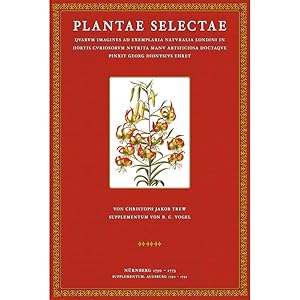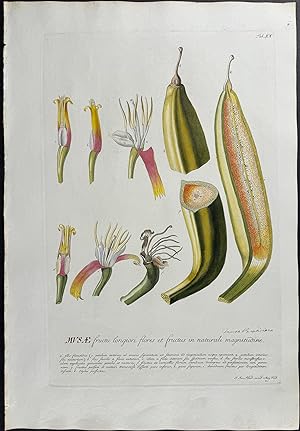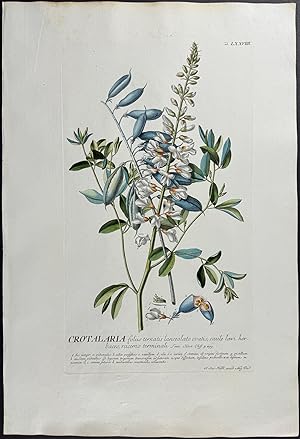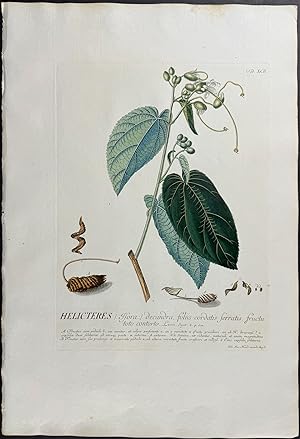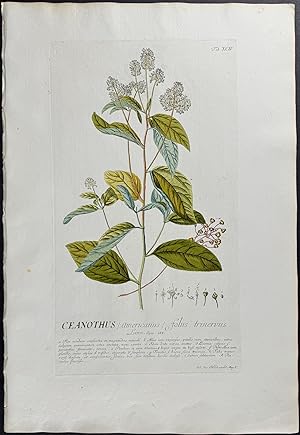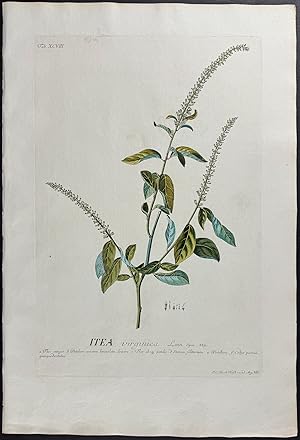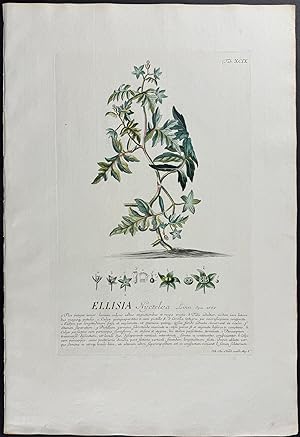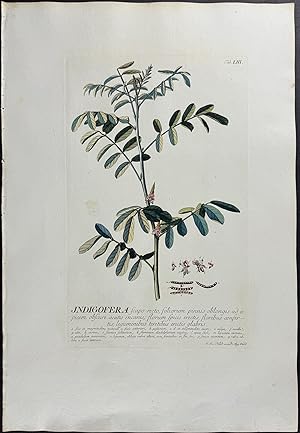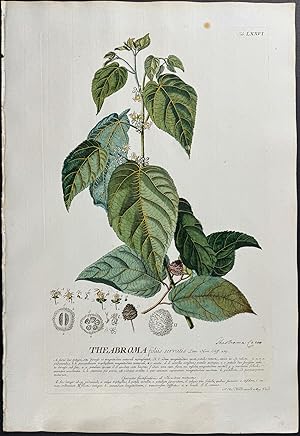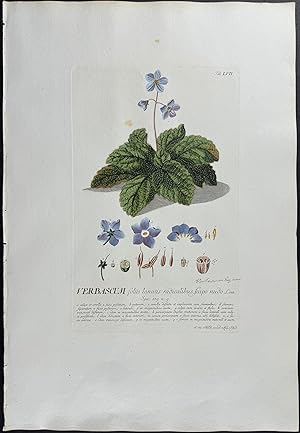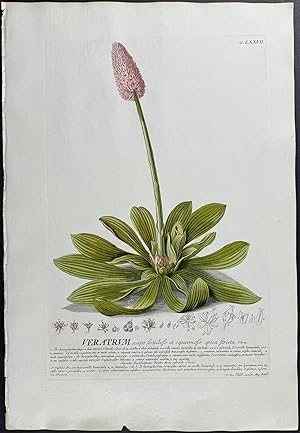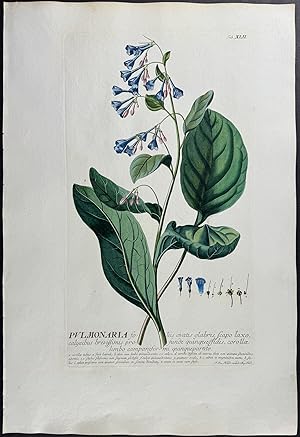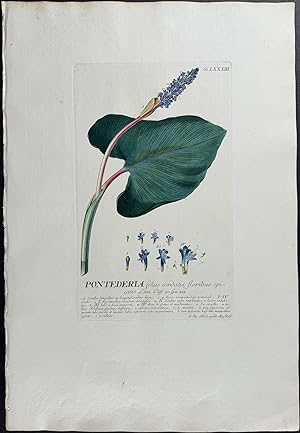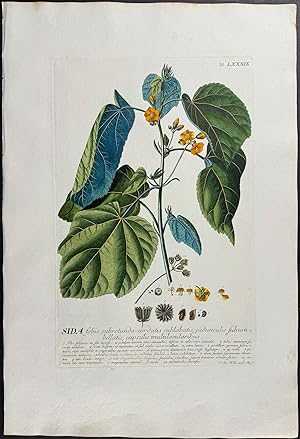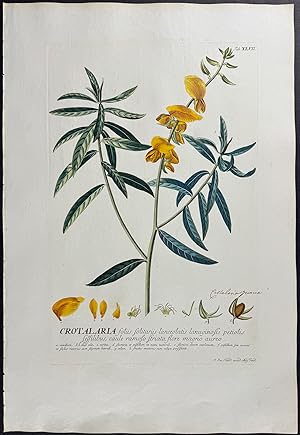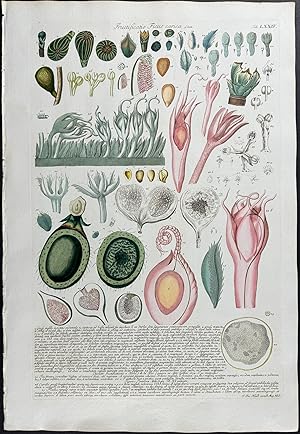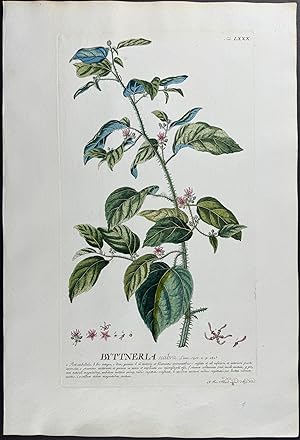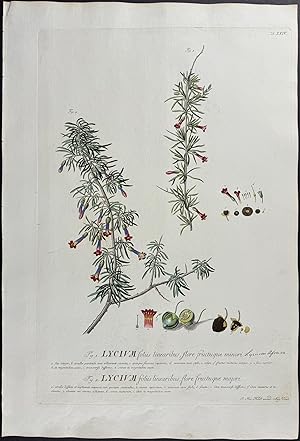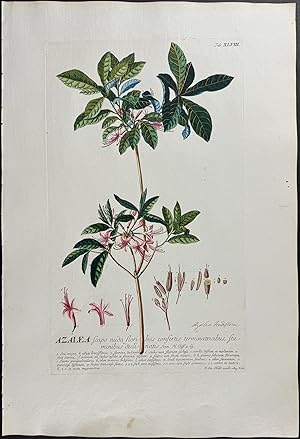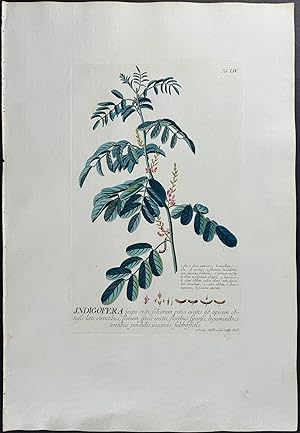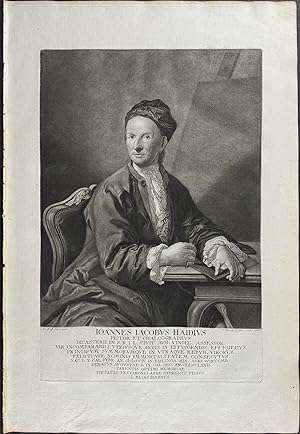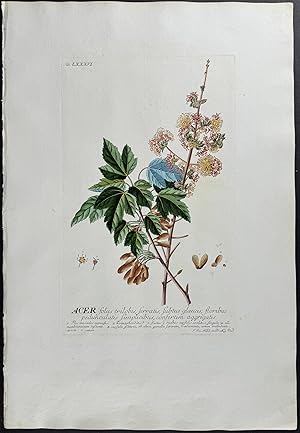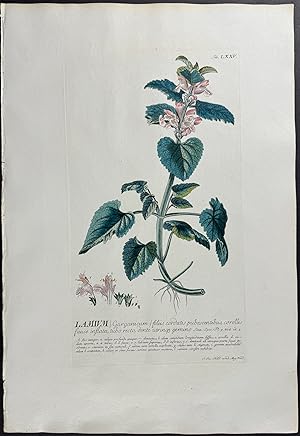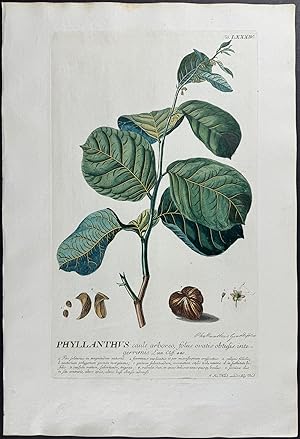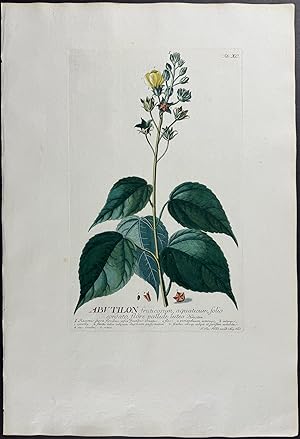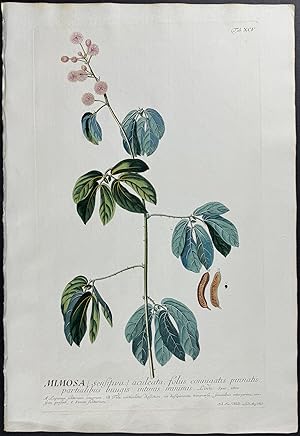trew georg dionysius ehret (113 résultats)
Type d'article
- Tous les types d'articles
- Livres (10)
- Magazines & Périodiques
- Bandes dessinées
- Partitions de musique
- Art, Affiches et Gravures (103)
- Photographies
- Cartes
-
Manuscrits &
Papiers anciens
Etat
Reliure
Particularités
- Edition originale
- Signé
- Jaquette
- Avec images (108)
- Sans impression à la demande (112)
Pays
Evaluation du vendeur
-
The Herbal of the Count Palatine
Edité par Harrap Publishers, Larousse, 1985
ISBN 10 : 0245543023ISBN 13 : 9780245543029
Vendeur : Better World Books Ltd, Dunfermline, Royaume-Uni
Livre
Etat : Good. Ships from the UK. Former library book; may include library markings. Used book that is in clean, average condition without any missing pages.
Plus de choix d'achat de la part d'autres vendeurs sur AbeBooks
Offres d'occasion à partir de EUR 6,90
-
The Herbal of the Count Palatine
Edité par Harrap, 1985
ISBN 10 : 0245543082ISBN 13 : 9780245543081
Vendeur : Booked Experiences Bookstore, Burlington, ON, Canada
Livre
Soft cover. Etat : Near Fine. Elizabeth Blackwell and Georg Dionysius Ehret (illustrateur). First. pp. 135 with index of names. an 18th c herbal with over 100 full colour illustrations Size: 8vo - over 7¾" - 9¾" tall.
-
Erlesene Pflanzen. Nach den 100 kolorierten Kupfern der "Plantae selectae" aus den Jahren 1750 - 1775.
Edité par Dortmund, Harenberg., 1981
ISBN 10 : 3883792551ISBN 13 : 9783883792552
Vendeur : Bibliotheca Botanica, Adendorf, Allemagne
Membre d'association : GIAQ
Livre
18 cm. 146 S. mit 100 farb. Tafeln, 8 Rotschwarze Titel sowie 3 schwarzweißen Portraittafeln. Taschenbuch (Softcover). Gutes Exemplar. Name a. Schmutztitel. Die bibliophilen Taschenbücher ; 255. Mit einem Nachwort von Edmund Launert. Sprache: Deutsch.
Plus de choix d'achat de la part d'autres vendeurs sur AbeBooks
Offres d'occasion à partir de EUR 8,76
-
Plantae selectae quarum imagines ad exemplaria naturalia Londini, in hortis curiosorum nutritamanu artificiosa doctaque pinxit Georgius Dionysius Ehret . ; occasione haud vulgari collegit nominibus propriis notisque subinde illustravit et publico usui dicavit D. Christophorus Iacobus Trevv . ; in aes incidit et vivis coloribus repraesentavit primum Ioannes Iacobus Haid . pictor et chalcographus augustanus. Volume 1-10 [LeatherBound]
Date d'édition : 2023
Vendeur : True World of Books, Delhi, Inde
Livre impression à la demande
LeatherBound. Etat : New. LeatherBound edition. Condition: New. Reprinted from 1750 edition. Leather Binding on Spine and Corners with Golden leaf printing on spine. Bound in genuine leather with Satin ribbon page markers and Spine with raised gilt bands. A perfect gift for your loved ones. NO changes have been made to the original text. This is NOT a retyped or an ocr'd reprint. Illustrations, Index, if any, are included in black and white. Each page is checked manually before printing. As this print on demand book is reprinted from a very old book, there could be some missing or flawed pages, but we always try to make the book as complete as possible. Fold-outs, if any, are not part of the book. If the original book was published in multiple volumes then this reprint is of only one volume, not the whole set. Sewing binding for longer life, where the book block is actually sewn (smythe sewn/section sewn) with thread before binding which results in a more durable type of binding. Pages: 175 Volume 1-10 Language: Latin.
-
Plantae selectae quarum imagines ad exemplaria naturalia Londini in hortis curiosorum nutritamanu artificiosa doctaque pinxit Georgius Dionysius Ehret in naes incidit et viviscoloribus repraesentavit Joannes Iacobus Haid
Edité par Fines Mundi GmbH Saarbrücken, 2008
ISBN 10 : 394769315XISBN 13 : 9783947693153
Vendeur : Versandantiquariat Nussbaum, Bernkastel-Kues, RP, Allemagne
Livre
Etat : Wie neu. VI, 70 Seiten, IV S. Mit 120 colorierten Tafeln und 4 Bildnissen Neu / 10 Teile in 1 Band incl. dem Supplementum plantarum selectarum. Die Vorlagen stammen vom Botaniker und Maler Georg Dionysius Ehret. Der Sammler, Förderer und Herausgeber Christoph Jakob Trew machte Ehrets Malkunst erstmals der Öffentlichkeit zugänglich. J. J. Haid war der beauftragte Kupferstecher, Drucker und Colorator des Werkes. Nach Trews Tod wurde das Prachtwerk unter der Leitung des Botanikers Benedict Christian Vogel mit 20 weiteren Tafeln vollendet und 1790 - 1792 mit einem Supplement herausgegeben. Mit Bildnissen von Ch. J. Trew, G. D. Ehret, B. C. Vogel und J. J. Haid Gegenüber dem Original um etwa 15 % verkleinerte Ausgabe. la Gewicht in Gramm: 3550 44,3 x 30,5 cm, gebundene Ausgabe Faksimile-Reprint der Ausgabe 1750-1773 Nürnberg und Augsburg.
-
Banana
Edité par Nuremberg, 1750
Vendeur : Trillium Antique Prints & Rare Books, Franklin, TN, Etats-Unis
Art / Affiche / Gravure
Etat : Fine. This elegant folio, botanical engraving is from Christoph Jakob Trewâ s work Plantae Selectae. The work was published in Nuremberg between 1750 and 1773. Georg Dionysius Ehret was the artist for the work and was considered one of the most influential artists in the world of botanical illustration. Ehretâ s plates are both remarkable and scientifically accurate. The original hand-coloring was completed by J. J. Haid.Plantae Selectae is one of the greatest of all eighteenth-century botanical books, drawn by the greatest of eighteenth-century botanical artists, George Dionysius Ehret. Linnaeus, wrote to Trew, in Latin, that "The miracles of our century in the natural sciences are your work of Ehret's plants.nothing to equal them was seen in the past or will be in the future."Christoph Jakob Trew, a physician and botanist, had for a number of years been an admirer of Ehret's work. Ehret, a brilliant botanical artist, was unrivalled in his ability to "achieve realism, majesty, ineffable colour, all in one breathtaking look." (Hunt) Born in Heidelberg in 1710, he originally worked as a gardener and practised drawing in his spare time. His artistic abilities led him to the service of a Regensburg banker named Leskenkohl, and it was during this period that Trew met Ehret.Trew was to remain a friend and patron of Ehret's throughout his life, and by 1742, the germ of what was to become the present publication was already under discussion when Trew wrote to Christian Thran in Carlsruhe "Every year I receive some beautifully painted exotic plants [by Ehret] and have already more than one hundred of them."Ehret moved to London in the late 1730s, where he painted the recently introduced exotics at the Chelsea Physic Garden and established himself as a teacher of flower-painting and botany. Discussions about the projected work continued by letter until 1748, when Johann Jacob Haid from Augsburg agreed to produce the engravings from Ehret's drawings. --- The work is in very good to excellent condition overall. There may be a few minor imperfections or faint marks to be expected with age. Please review the image carefully for condition and contact us with any questions. --- Paper Size ~ 13 1/2" by 20 1/4".
-
Rattlepod
Edité par Nuremberg, 1750
Vendeur : Trillium Antique Prints & Rare Books, Franklin, TN, Etats-Unis
Art / Affiche / Gravure
Etat : Fine. This elegant folio, botanical engraving is from Christoph Jakob Trewâ s work Plantae Selectae. The work was published in Nuremberg between 1750 and 1773. Georg Dionysius Ehret was the artist for the work and was considered one of the most influential artists in the world of botanical illustration. Ehretâ s plates are both remarkable and scientifically accurate. The original hand-coloring was completed by J. J. Haid.Plantae Selectae is one of the greatest of all eighteenth-century botanical books, drawn by the greatest of eighteenth-century botanical artists, George Dionysius Ehret. Linnaeus, wrote to Trew, in Latin, that "The miracles of our century in the natural sciences are your work of Ehret's plants.nothing to equal them was seen in the past or will be in the future."Christoph Jakob Trew, a physician and botanist, had for a number of years been an admirer of Ehret's work. Ehret, a brilliant botanical artist, was unrivalled in his ability to "achieve realism, majesty, ineffable colour, all in one breathtaking look." (Hunt) Born in Heidelberg in 1710, he originally worked as a gardener and practised drawing in his spare time. His artistic abilities led him to the service of a Regensburg banker named Leskenkohl, and it was during this period that Trew met Ehret.Trew was to remain a friend and patron of Ehret's throughout his life, and by 1742, the germ of what was to become the present publication was already under discussion when Trew wrote to Christian Thran in Carlsruhe "Every year I receive some beautifully painted exotic plants [by Ehret] and have already more than one hundred of them."Ehret moved to London in the late 1730s, where he painted the recently introduced exotics at the Chelsea Physic Garden and established himself as a teacher of flower-painting and botany. Discussions about the projected work continued by letter until 1748, when Johann Jacob Haid from Augsburg agreed to produce the engravings from Ehret's drawings. --- The work is in very good to excellent condition overall. There may be a few minor imperfections or faint marks to be expected with age. Please review the image carefully for condition and contact us with any questions. --- Paper Size ~ 13 1/2" by 20 1/4".
-
Indian Screw Tree
Edité par Nuremberg, 1750
Vendeur : Trillium Antique Prints & Rare Books, Franklin, TN, Etats-Unis
Art / Affiche / Gravure
Etat : Fine. This elegant folio, botanical engraving is from Christoph Jakob Trewâ s work Plantae Selectae. The work was published in Nuremberg between 1750 and 1773. Georg Dionysius Ehret was the artist for the work and was considered one of the most influential artists in the world of botanical illustration. Ehretâ s plates are both remarkable and scientifically accurate. The original hand-coloring was completed by J. J. Haid.Plantae Selectae is one of the greatest of all eighteenth-century botanical books, drawn by the greatest of eighteenth-century botanical artists, George Dionysius Ehret. Linnaeus, wrote to Trew, in Latin, that "The miracles of our century in the natural sciences are your work of Ehret's plants.nothing to equal them was seen in the past or will be in the future."Christoph Jakob Trew, a physician and botanist, had for a number of years been an admirer of Ehret's work. Ehret, a brilliant botanical artist, was unrivalled in his ability to "achieve realism, majesty, ineffable colour, all in one breathtaking look." (Hunt) Born in Heidelberg in 1710, he originally worked as a gardener and practised drawing in his spare time. His artistic abilities led him to the service of a Regensburg banker named Leskenkohl, and it was during this period that Trew met Ehret.Trew was to remain a friend and patron of Ehret's throughout his life, and by 1742, the germ of what was to become the present publication was already under discussion when Trew wrote to Christian Thran in Carlsruhe "Every year I receive some beautifully painted exotic plants [by Ehret] and have already more than one hundred of them."Ehret moved to London in the late 1730s, where he painted the recently introduced exotics at the Chelsea Physic Garden and established himself as a teacher of flower-painting and botany. Discussions about the projected work continued by letter until 1748, when Johann Jacob Haid from Augsburg agreed to produce the engravings from Ehret's drawings. --- The work is in very good to excellent condition overall. There may be a few minor imperfections or faint marks to be expected with age. Please review the image carefully for condition and contact us with any questions. --- Paper Size ~ 13 1/2" by 20 1/4".
-
California Lilac
Edité par Nuremberg, 1750
Vendeur : Trillium Antique Prints & Rare Books, Franklin, TN, Etats-Unis
Art / Affiche / Gravure
Etat : Fine. This elegant folio, botanical engraving is from Christoph Jakob Trewâ s work Plantae Selectae. The work was published in Nuremberg between 1750 and 1773. Georg Dionysius Ehret was the artist for the work and was considered one of the most influential artists in the world of botanical illustration. Ehretâ s plates are both remarkable and scientifically accurate. The original hand-coloring was completed by J. J. Haid.Plantae Selectae is one of the greatest of all eighteenth-century botanical books, drawn by the greatest of eighteenth-century botanical artists, George Dionysius Ehret. Linnaeus, wrote to Trew, in Latin, that "The miracles of our century in the natural sciences are your work of Ehret's plants.nothing to equal them was seen in the past or will be in the future."Christoph Jakob Trew, a physician and botanist, had for a number of years been an admirer of Ehret's work. Ehret, a brilliant botanical artist, was unrivalled in his ability to "achieve realism, majesty, ineffable colour, all in one breathtaking look." (Hunt) Born in Heidelberg in 1710, he originally worked as a gardener and practised drawing in his spare time. His artistic abilities led him to the service of a Regensburg banker named Leskenkohl, and it was during this period that Trew met Ehret.Trew was to remain a friend and patron of Ehret's throughout his life, and by 1742, the germ of what was to become the present publication was already under discussion when Trew wrote to Christian Thran in Carlsruhe "Every year I receive some beautifully painted exotic plants [by Ehret] and have already more than one hundred of them."Ehret moved to London in the late 1730s, where he painted the recently introduced exotics at the Chelsea Physic Garden and established himself as a teacher of flower-painting and botany. Discussions about the projected work continued by letter until 1748, when Johann Jacob Haid from Augsburg agreed to produce the engravings from Ehret's drawings. --- The work is in very good to excellent condition overall. There may be a few minor imperfections or faint marks to be expected with age. Please review the image carefully for condition and contact us with any questions. --- Paper Size ~ 13 1/2" by 20 1/4".
-
Itea
Edité par Nuremberg, 1750
Vendeur : Trillium Antique Prints & Rare Books, Franklin, TN, Etats-Unis
Art / Affiche / Gravure
Etat : Fine. This elegant folio, botanical engraving is from Christoph Jakob Trewâ s work Plantae Selectae. The work was published in Nuremberg between 1750 and 1773. Georg Dionysius Ehret was the artist for the work and was considered one of the most influential artists in the world of botanical illustration. Ehretâ s plates are both remarkable and scientifically accurate. The original hand-coloring was completed by J. J. Haid.Plantae Selectae is one of the greatest of all eighteenth-century botanical books, drawn by the greatest of eighteenth-century botanical artists, George Dionysius Ehret. Linnaeus, wrote to Trew, in Latin, that "The miracles of our century in the natural sciences are your work of Ehret's plants.nothing to equal them was seen in the past or will be in the future."Christoph Jakob Trew, a physician and botanist, had for a number of years been an admirer of Ehret's work. Ehret, a brilliant botanical artist, was unrivalled in his ability to "achieve realism, majesty, ineffable colour, all in one breathtaking look." (Hunt) Born in Heidelberg in 1710, he originally worked as a gardener and practised drawing in his spare time. His artistic abilities led him to the service of a Regensburg banker named Leskenkohl, and it was during this period that Trew met Ehret.Trew was to remain a friend and patron of Ehret's throughout his life, and by 1742, the germ of what was to become the present publication was already under discussion when Trew wrote to Christian Thran in Carlsruhe "Every year I receive some beautifully painted exotic plants [by Ehret] and have already more than one hundred of them."Ehret moved to London in the late 1730s, where he painted the recently introduced exotics at the Chelsea Physic Garden and established himself as a teacher of flower-painting and botany. Discussions about the projected work continued by letter until 1748, when Johann Jacob Haid from Augsburg agreed to produce the engravings from Ehret's drawings. --- The work is in very good to excellent condition overall. There may be a few minor imperfections or faint marks to be expected with age. Please review the image carefully for condition and contact us with any questions. --- Paper Size ~ 13 1/2" by 20 1/4".
-
Ellisia
Edité par Nuremberg, 1750
Vendeur : Trillium Antique Prints & Rare Books, Franklin, TN, Etats-Unis
Art / Affiche / Gravure
Etat : Fine. This elegant folio, botanical engraving is from Christoph Jakob Trewâ s work Plantae Selectae. The work was published in Nuremberg between 1750 and 1773. Georg Dionysius Ehret was the artist for the work and was considered one of the most influential artists in the world of botanical illustration. Ehretâ s plates are both remarkable and scientifically accurate. The original hand-coloring was completed by J. J. Haid.Plantae Selectae is one of the greatest of all eighteenth-century botanical books, drawn by the greatest of eighteenth-century botanical artists, George Dionysius Ehret. Linnaeus, wrote to Trew, in Latin, that "The miracles of our century in the natural sciences are your work of Ehret's plants.nothing to equal them was seen in the past or will be in the future."Christoph Jakob Trew, a physician and botanist, had for a number of years been an admirer of Ehret's work. Ehret, a brilliant botanical artist, was unrivalled in his ability to "achieve realism, majesty, ineffable colour, all in one breathtaking look." (Hunt) Born in Heidelberg in 1710, he originally worked as a gardener and practised drawing in his spare time. His artistic abilities led him to the service of a Regensburg banker named Leskenkohl, and it was during this period that Trew met Ehret.Trew was to remain a friend and patron of Ehret's throughout his life, and by 1742, the germ of what was to become the present publication was already under discussion when Trew wrote to Christian Thran in Carlsruhe "Every year I receive some beautifully painted exotic plants [by Ehret] and have already more than one hundred of them."Ehret moved to London in the late 1730s, where he painted the recently introduced exotics at the Chelsea Physic Garden and established himself as a teacher of flower-painting and botany. Discussions about the projected work continued by letter until 1748, when Johann Jacob Haid from Augsburg agreed to produce the engravings from Ehret's drawings. --- The work is in very good to excellent condition overall. There may be a few minor imperfections or faint marks to be expected with age. Please review the image carefully for condition and contact us with any questions. --- Paper Size ~ 13 1/2" by 20 1/4".
-
Indigo
Edité par Nuremberg, 1750
Vendeur : Trillium Antique Prints & Rare Books, Franklin, TN, Etats-Unis
Art / Affiche / Gravure
Etat : Fine. This elegant folio, botanical engraving is from Christoph Jakob Trewâ s work Plantae Selectae. The work was published in Nuremberg between 1750 and 1773. Georg Dionysius Ehret was the artist for the work and was considered one of the most influential artists in the world of botanical illustration. Ehretâ s plates are both remarkable and scientifically accurate. The original hand-coloring was completed by J. J. Haid.Plantae Selectae is one of the greatest of all eighteenth-century botanical books, drawn by the greatest of eighteenth-century botanical artists, George Dionysius Ehret. Linnaeus, wrote to Trew, in Latin, that "The miracles of our century in the natural sciences are your work of Ehret's plants.nothing to equal them was seen in the past or will be in the future."Christoph Jakob Trew, a physician and botanist, had for a number of years been an admirer of Ehret's work. Ehret, a brilliant botanical artist, was unrivalled in his ability to "achieve realism, majesty, ineffable colour, all in one breathtaking look." (Hunt) Born in Heidelberg in 1710, he originally worked as a gardener and practised drawing in his spare time. His artistic abilities led him to the service of a Regensburg banker named Leskenkohl, and it was during this period that Trew met Ehret.Trew was to remain a friend and patron of Ehret's throughout his life, and by 1742, the germ of what was to become the present publication was already under discussion when Trew wrote to Christian Thran in Carlsruhe "Every year I receive some beautifully painted exotic plants [by Ehret] and have already more than one hundred of them."Ehret moved to London in the late 1730s, where he painted the recently introduced exotics at the Chelsea Physic Garden and established himself as a teacher of flower-painting and botany. Discussions about the projected work continued by letter until 1748, when Johann Jacob Haid from Augsburg agreed to produce the engravings from Ehret's drawings. --- The work is in very good to excellent condition overall. There may be a few minor imperfections or faint marks to be expected with age. Please review the image carefully for condition and contact us with any questions. --- Paper Size ~ 13 1/2" by 20 1/4".
-
Cocoa Tree
Edité par Nuremberg, 1750
Vendeur : Trillium Antique Prints & Rare Books, Franklin, TN, Etats-Unis
Art / Affiche / Gravure
Etat : Fine. This elegant folio, botanical engraving is from Christoph Jakob Trewâ s work Plantae Selectae. The work was published in Nuremberg between 1750 and 1773. Georg Dionysius Ehret was the artist for the work and was considered one of the most influential artists in the world of botanical illustration. Ehretâ s plates are both remarkable and scientifically accurate. The original hand-coloring was completed by J. J. Haid.Plantae Selectae is one of the greatest of all eighteenth-century botanical books, drawn by the greatest of eighteenth-century botanical artists, George Dionysius Ehret. Linnaeus, wrote to Trew, in Latin, that "The miracles of our century in the natural sciences are your work of Ehret's plants.nothing to equal them was seen in the past or will be in the future."Christoph Jakob Trew, a physician and botanist, had for a number of years been an admirer of Ehret's work. Ehret, a brilliant botanical artist, was unrivalled in his ability to "achieve realism, majesty, ineffable colour, all in one breathtaking look." (Hunt) Born in Heidelberg in 1710, he originally worked as a gardener and practised drawing in his spare time. His artistic abilities led him to the service of a Regensburg banker named Leskenkohl, and it was during this period that Trew met Ehret.Trew was to remain a friend and patron of Ehret's throughout his life, and by 1742, the germ of what was to become the present publication was already under discussion when Trew wrote to Christian Thran in Carlsruhe "Every year I receive some beautifully painted exotic plants [by Ehret] and have already more than one hundred of them."Ehret moved to London in the late 1730s, where he painted the recently introduced exotics at the Chelsea Physic Garden and established himself as a teacher of flower-painting and botany. Discussions about the projected work continued by letter until 1748, when Johann Jacob Haid from Augsburg agreed to produce the engravings from Ehret's drawings. --- The work is in very good to excellent condition overall. There may be a few minor imperfections or faint marks to be expected with age. Please review the image carefully for condition and contact us with any questions. --- Paper Size ~ 13 1/2" by 20 1/4".
-
Mullein
Edité par Nuremberg, 1750
Vendeur : Trillium Antique Prints & Rare Books, Franklin, TN, Etats-Unis
Art / Affiche / Gravure
Etat : Fine. This elegant folio, botanical engraving is from Christoph Jakob Trewâ s work Plantae Selectae. The work was published in Nuremberg between 1750 and 1773. Georg Dionysius Ehret was the artist for the work and was considered one of the most influential artists in the world of botanical illustration. Ehretâ s plates are both remarkable and scientifically accurate. The original hand-coloring was completed by J. J. Haid.Plantae Selectae is one of the greatest of all eighteenth-century botanical books, drawn by the greatest of eighteenth-century botanical artists, George Dionysius Ehret. Linnaeus, wrote to Trew, in Latin, that "The miracles of our century in the natural sciences are your work of Ehret's plants.nothing to equal them was seen in the past or will be in the future."Christoph Jakob Trew, a physician and botanist, had for a number of years been an admirer of Ehret's work. Ehret, a brilliant botanical artist, was unrivalled in his ability to "achieve realism, majesty, ineffable colour, all in one breathtaking look." (Hunt) Born in Heidelberg in 1710, he originally worked as a gardener and practised drawing in his spare time. His artistic abilities led him to the service of a Regensburg banker named Leskenkohl, and it was during this period that Trew met Ehret.Trew was to remain a friend and patron of Ehret's throughout his life, and by 1742, the germ of what was to become the present publication was already under discussion when Trew wrote to Christian Thran in Carlsruhe "Every year I receive some beautifully painted exotic plants [by Ehret] and have already more than one hundred of them."Ehret moved to London in the late 1730s, where he painted the recently introduced exotics at the Chelsea Physic Garden and established himself as a teacher of flower-painting and botany. Discussions about the projected work continued by letter until 1748, when Johann Jacob Haid from Augsburg agreed to produce the engravings from Ehret's drawings. --- The work is in very good to excellent condition overall. There may be a few minor imperfections or faint marks to be expected with age. Please review the image carefully for condition and contact us with any questions. --- Paper Size ~ 13 1/2" by 20 1/4".
-
Indian Poke
Edité par Nuremberg, 1750
Vendeur : Trillium Antique Prints & Rare Books, Franklin, TN, Etats-Unis
Art / Affiche / Gravure
Etat : Fine. This elegant folio, botanical engraving is from Christoph Jakob Trewâ s work Plantae Selectae. The work was published in Nuremberg between 1750 and 1773. Georg Dionysius Ehret was the artist for the work and was considered one of the most influential artists in the world of botanical illustration. Ehretâ s plates are both remarkable and scientifically accurate. The original hand-coloring was completed by J. J. Haid.Plantae Selectae is one of the greatest of all eighteenth-century botanical books, drawn by the greatest of eighteenth-century botanical artists, George Dionysius Ehret. Linnaeus, wrote to Trew, in Latin, that "The miracles of our century in the natural sciences are your work of Ehret's plants.nothing to equal them was seen in the past or will be in the future."Christoph Jakob Trew, a physician and botanist, had for a number of years been an admirer of Ehret's work. Ehret, a brilliant botanical artist, was unrivalled in his ability to "achieve realism, majesty, ineffable colour, all in one breathtaking look." (Hunt) Born in Heidelberg in 1710, he originally worked as a gardener and practised drawing in his spare time. His artistic abilities led him to the service of a Regensburg banker named Leskenkohl, and it was during this period that Trew met Ehret.Trew was to remain a friend and patron of Ehret's throughout his life, and by 1742, the germ of what was to become the present publication was already under discussion when Trew wrote to Christian Thran in Carlsruhe "Every year I receive some beautifully painted exotic plants [by Ehret] and have already more than one hundred of them."Ehret moved to London in the late 1730s, where he painted the recently introduced exotics at the Chelsea Physic Garden and established himself as a teacher of flower-painting and botany. Discussions about the projected work continued by letter until 1748, when Johann Jacob Haid from Augsburg agreed to produce the engravings from Ehret's drawings. --- The work is in very good to excellent condition overall. There may be a few minor imperfections or faint marks to be expected with age. Please review the image carefully for condition and contact us with any questions. --- Paper Size ~ 13 1/2" by 20 1/4".
-
Lungwort
Edité par Nuremberg, 1750
Vendeur : Trillium Antique Prints & Rare Books, Franklin, TN, Etats-Unis
Art / Affiche / Gravure
Etat : Fine. This elegant folio, botanical engraving is from Christoph Jakob Trewâ s work Plantae Selectae. The work was published in Nuremberg between 1750 and 1773. Georg Dionysius Ehret was the artist for the work and was considered one of the most influential artists in the world of botanical illustration. Ehretâ s plates are both remarkable and scientifically accurate. The original hand-coloring was completed by J. J. Haid.Plantae Selectae is one of the greatest of all eighteenth-century botanical books, drawn by the greatest of eighteenth-century botanical artists, George Dionysius Ehret. Linnaeus, wrote to Trew, in Latin, that "The miracles of our century in the natural sciences are your work of Ehret's plants.nothing to equal them was seen in the past or will be in the future."Christoph Jakob Trew, a physician and botanist, had for a number of years been an admirer of Ehret's work. Ehret, a brilliant botanical artist, was unrivalled in his ability to "achieve realism, majesty, ineffable colour, all in one breathtaking look." (Hunt) Born in Heidelberg in 1710, he originally worked as a gardener and practised drawing in his spare time. His artistic abilities led him to the service of a Regensburg banker named Leskenkohl, and it was during this period that Trew met Ehret.Trew was to remain a friend and patron of Ehret's throughout his life, and by 1742, the germ of what was to become the present publication was already under discussion when Trew wrote to Christian Thran in Carlsruhe "Every year I receive some beautifully painted exotic plants [by Ehret] and have already more than one hundred of them."Ehret moved to London in the late 1730s, where he painted the recently introduced exotics at the Chelsea Physic Garden and established himself as a teacher of flower-painting and botany. Discussions about the projected work continued by letter until 1748, when Johann Jacob Haid from Augsburg agreed to produce the engravings from Ehret's drawings. --- The work is in very good to excellent condition overall. There may be a few minor imperfections or faint marks to be expected with age. Please review the image carefully for condition and contact us with any questions. --- Paper Size ~ 13 1/2" by 20 1/4".
-
Pickerelweed
Edité par Nuremberg, 1750
Vendeur : Trillium Antique Prints & Rare Books, Franklin, TN, Etats-Unis
Art / Affiche / Gravure
Etat : Fine. This elegant folio, botanical engraving is from Christoph Jakob Trewâ s work Plantae Selectae. The work was published in Nuremberg between 1750 and 1773. Georg Dionysius Ehret was the artist for the work and was considered one of the most influential artists in the world of botanical illustration. Ehretâ s plates are both remarkable and scientifically accurate. The original hand-coloring was completed by J. J. Haid.Plantae Selectae is one of the greatest of all eighteenth-century botanical books, drawn by the greatest of eighteenth-century botanical artists, George Dionysius Ehret. Linnaeus, wrote to Trew, in Latin, that "The miracles of our century in the natural sciences are your work of Ehret's plants.nothing to equal them was seen in the past or will be in the future."Christoph Jakob Trew, a physician and botanist, had for a number of years been an admirer of Ehret's work. Ehret, a brilliant botanical artist, was unrivalled in his ability to "achieve realism, majesty, ineffable colour, all in one breathtaking look." (Hunt) Born in Heidelberg in 1710, he originally worked as a gardener and practised drawing in his spare time. His artistic abilities led him to the service of a Regensburg banker named Leskenkohl, and it was during this period that Trew met Ehret.Trew was to remain a friend and patron of Ehret's throughout his life, and by 1742, the germ of what was to become the present publication was already under discussion when Trew wrote to Christian Thran in Carlsruhe "Every year I receive some beautifully painted exotic plants [by Ehret] and have already more than one hundred of them."Ehret moved to London in the late 1730s, where he painted the recently introduced exotics at the Chelsea Physic Garden and established himself as a teacher of flower-painting and botany. Discussions about the projected work continued by letter until 1748, when Johann Jacob Haid from Augsburg agreed to produce the engravings from Ehret's drawings. --- The work is in very good to excellent condition overall. There may be a few minor imperfections or faint marks to be expected with age. Please review the image carefully for condition and contact us with any questions. --- Paper Size ~ 13 1/2" by 20 1/4".
-
Sida
Edité par Nuremberg, 1750
Vendeur : Trillium Antique Prints & Rare Books, Franklin, TN, Etats-Unis
Art / Affiche / Gravure
Etat : Fine. This elegant folio, botanical engraving is from Christoph Jakob Trewâ s work Plantae Selectae. The work was published in Nuremberg between 1750 and 1773. Georg Dionysius Ehret was the artist for the work and was considered one of the most influential artists in the world of botanical illustration. Ehretâ s plates are both remarkable and scientifically accurate. The original hand-coloring was completed by J. J. Haid.Plantae Selectae is one of the greatest of all eighteenth-century botanical books, drawn by the greatest of eighteenth-century botanical artists, George Dionysius Ehret. Linnaeus, wrote to Trew, in Latin, that "The miracles of our century in the natural sciences are your work of Ehret's plants.nothing to equal them was seen in the past or will be in the future."Christoph Jakob Trew, a physician and botanist, had for a number of years been an admirer of Ehret's work. Ehret, a brilliant botanical artist, was unrivalled in his ability to "achieve realism, majesty, ineffable colour, all in one breathtaking look." (Hunt) Born in Heidelberg in 1710, he originally worked as a gardener and practised drawing in his spare time. His artistic abilities led him to the service of a Regensburg banker named Leskenkohl, and it was during this period that Trew met Ehret.Trew was to remain a friend and patron of Ehret's throughout his life, and by 1742, the germ of what was to become the present publication was already under discussion when Trew wrote to Christian Thran in Carlsruhe "Every year I receive some beautifully painted exotic plants [by Ehret] and have already more than one hundred of them."Ehret moved to London in the late 1730s, where he painted the recently introduced exotics at the Chelsea Physic Garden and established himself as a teacher of flower-painting and botany. Discussions about the projected work continued by letter until 1748, when Johann Jacob Haid from Augsburg agreed to produce the engravings from Ehret's drawings. --- The work is in very good to excellent condition overall. There may be a few minor imperfections or faint marks to be expected with age. Please review the image carefully for condition and contact us with any questions. --- Paper Size ~ 13 1/2" by 20 1/4".
-
Rattlepod
Edité par Nuremberg, 1750
Vendeur : Trillium Antique Prints & Rare Books, Franklin, TN, Etats-Unis
Art / Affiche / Gravure
Etat : Fine. This elegant folio, botanical engraving is from Christoph Jakob Trewâ s work Plantae Selectae. The work was published in Nuremberg between 1750 and 1773. Georg Dionysius Ehret was the artist for the work and was considered one of the most influential artists in the world of botanical illustration. Ehretâ s plates are both remarkable and scientifically accurate. The original hand-coloring was completed by J. J. Haid.Plantae Selectae is one of the greatest of all eighteenth-century botanical books, drawn by the greatest of eighteenth-century botanical artists, George Dionysius Ehret. Linnaeus, wrote to Trew, in Latin, that "The miracles of our century in the natural sciences are your work of Ehret's plants.nothing to equal them was seen in the past or will be in the future."Christoph Jakob Trew, a physician and botanist, had for a number of years been an admirer of Ehret's work. Ehret, a brilliant botanical artist, was unrivalled in his ability to "achieve realism, majesty, ineffable colour, all in one breathtaking look." (Hunt) Born in Heidelberg in 1710, he originally worked as a gardener and practised drawing in his spare time. His artistic abilities led him to the service of a Regensburg banker named Leskenkohl, and it was during this period that Trew met Ehret.Trew was to remain a friend and patron of Ehret's throughout his life, and by 1742, the germ of what was to become the present publication was already under discussion when Trew wrote to Christian Thran in Carlsruhe "Every year I receive some beautifully painted exotic plants [by Ehret] and have already more than one hundred of them."Ehret moved to London in the late 1730s, where he painted the recently introduced exotics at the Chelsea Physic Garden and established himself as a teacher of flower-painting and botany. Discussions about the projected work continued by letter until 1748, when Johann Jacob Haid from Augsburg agreed to produce the engravings from Ehret's drawings. --- The work is in very good to excellent condition overall. There may be a few minor imperfections or faint marks to be expected with age. Please review the image carefully for condition and contact us with any questions. --- Paper Size ~ 13 1/2" by 20 1/4".
-
Ficus Dissections
Edité par Nuremberg, 1750
Vendeur : Trillium Antique Prints & Rare Books, Franklin, TN, Etats-Unis
Art / Affiche / Gravure
Etat : Fine. This elegant folio, botanical engraving is from Christoph Jakob Trewâ s work Plantae Selectae. The work was published in Nuremberg between 1750 and 1773. Georg Dionysius Ehret was the artist for the work and was considered one of the most influential artists in the world of botanical illustration. Ehretâ s plates are both remarkable and scientifically accurate. The original hand-coloring was completed by J. J. Haid.Plantae Selectae is one of the greatest of all eighteenth-century botanical books, drawn by the greatest of eighteenth-century botanical artists, George Dionysius Ehret. Linnaeus, wrote to Trew, in Latin, that "The miracles of our century in the natural sciences are your work of Ehret's plants.nothing to equal them was seen in the past or will be in the future."Christoph Jakob Trew, a physician and botanist, had for a number of years been an admirer of Ehret's work. Ehret, a brilliant botanical artist, was unrivalled in his ability to "achieve realism, majesty, ineffable colour, all in one breathtaking look." (Hunt) Born in Heidelberg in 1710, he originally worked as a gardener and practised drawing in his spare time. His artistic abilities led him to the service of a Regensburg banker named Leskenkohl, and it was during this period that Trew met Ehret.Trew was to remain a friend and patron of Ehret's throughout his life, and by 1742, the germ of what was to become the present publication was already under discussion when Trew wrote to Christian Thran in Carlsruhe "Every year I receive some beautifully painted exotic plants [by Ehret] and have already more than one hundred of them."Ehret moved to London in the late 1730s, where he painted the recently introduced exotics at the Chelsea Physic Garden and established himself as a teacher of flower-painting and botany. Discussions about the projected work continued by letter until 1748, when Johann Jacob Haid from Augsburg agreed to produce the engravings from Ehret's drawings. --- The work is in very good to excellent condition overall. There may be a few minor imperfections or faint marks to be expected with age. Please review the image carefully for condition and contact us with any questions. --- Paper Size ~ 13 1/2" by 20 1/4".
-
Byttneria
Edité par Nuremberg, 1750
Vendeur : Trillium Antique Prints & Rare Books, Franklin, TN, Etats-Unis
Art / Affiche / Gravure
Etat : Fine. This elegant folio, botanical engraving is from Christoph Jakob Trewâ s work Plantae Selectae. The work was published in Nuremberg between 1750 and 1773. Georg Dionysius Ehret was the artist for the work and was considered one of the most influential artists in the world of botanical illustration. Ehretâ s plates are both remarkable and scientifically accurate. The original hand-coloring was completed by J. J. Haid.Plantae Selectae is one of the greatest of all eighteenth-century botanical books, drawn by the greatest of eighteenth-century botanical artists, George Dionysius Ehret. Linnaeus, wrote to Trew, in Latin, that "The miracles of our century in the natural sciences are your work of Ehret's plants.nothing to equal them was seen in the past or will be in the future."Christoph Jakob Trew, a physician and botanist, had for a number of years been an admirer of Ehret's work. Ehret, a brilliant botanical artist, was unrivalled in his ability to "achieve realism, majesty, ineffable colour, all in one breathtaking look." (Hunt) Born in Heidelberg in 1710, he originally worked as a gardener and practised drawing in his spare time. His artistic abilities led him to the service of a Regensburg banker named Leskenkohl, and it was during this period that Trew met Ehret.Trew was to remain a friend and patron of Ehret's throughout his life, and by 1742, the germ of what was to become the present publication was already under discussion when Trew wrote to Christian Thran in Carlsruhe "Every year I receive some beautifully painted exotic plants [by Ehret] and have already more than one hundred of them."Ehret moved to London in the late 1730s, where he painted the recently introduced exotics at the Chelsea Physic Garden and established himself as a teacher of flower-painting and botany. Discussions about the projected work continued by letter until 1748, when Johann Jacob Haid from Augsburg agreed to produce the engravings from Ehret's drawings. --- The work is in very good to excellent condition overall. There may be a few minor imperfections or faint marks to be expected with age. Please review the image carefully for condition and contact us with any questions. --- Paper Size ~ 13 1/2" by 20 1/4".
-
Nightshade
Edité par Nuremberg, 1750
Vendeur : Trillium Antique Prints & Rare Books, Franklin, TN, Etats-Unis
Art / Affiche / Gravure
Etat : Fine. This elegant folio, botanical engraving is from Christoph Jakob Trewâ s work Plantae Selectae. The work was published in Nuremberg between 1750 and 1773. Georg Dionysius Ehret was the artist for the work and was considered one of the most influential artists in the world of botanical illustration. Ehretâ s plates are both remarkable and scientifically accurate. The original hand-coloring was completed by J. J. Haid.Plantae Selectae is one of the greatest of all eighteenth-century botanical books, drawn by the greatest of eighteenth-century botanical artists, George Dionysius Ehret. Linnaeus, wrote to Trew, in Latin, that "The miracles of our century in the natural sciences are your work of Ehret's plants.nothing to equal them was seen in the past or will be in the future."Christoph Jakob Trew, a physician and botanist, had for a number of years been an admirer of Ehret's work. Ehret, a brilliant botanical artist, was unrivalled in his ability to "achieve realism, majesty, ineffable colour, all in one breathtaking look." (Hunt) Born in Heidelberg in 1710, he originally worked as a gardener and practised drawing in his spare time. His artistic abilities led him to the service of a Regensburg banker named Leskenkohl, and it was during this period that Trew met Ehret.Trew was to remain a friend and patron of Ehret's throughout his life, and by 1742, the germ of what was to become the present publication was already under discussion when Trew wrote to Christian Thran in Carlsruhe "Every year I receive some beautifully painted exotic plants [by Ehret] and have already more than one hundred of them."Ehret moved to London in the late 1730s, where he painted the recently introduced exotics at the Chelsea Physic Garden and established himself as a teacher of flower-painting and botany. Discussions about the projected work continued by letter until 1748, when Johann Jacob Haid from Augsburg agreed to produce the engravings from Ehret's drawings. --- The work is in very good to excellent condition overall. There may be a few minor imperfections or faint marks to be expected with age. Please review the image carefully for condition and contact us with any questions. --- Paper Size ~ 13 1/2" by 20 1/4".
-
Azalea
Edité par Nuremberg, 1750
Vendeur : Trillium Antique Prints & Rare Books, Franklin, TN, Etats-Unis
Art / Affiche / Gravure
Etat : Fine. This elegant folio, botanical engraving is from Christoph Jakob Trewâ s work Plantae Selectae. The work was published in Nuremberg between 1750 and 1773. Georg Dionysius Ehret was the artist for the work and was considered one of the most influential artists in the world of botanical illustration. Ehretâ s plates are both remarkable and scientifically accurate. The original hand-coloring was completed by J. J. Haid.Plantae Selectae is one of the greatest of all eighteenth-century botanical books, drawn by the greatest of eighteenth-century botanical artists, George Dionysius Ehret. Linnaeus, wrote to Trew, in Latin, that "The miracles of our century in the natural sciences are your work of Ehret's plants.nothing to equal them was seen in the past or will be in the future."Christoph Jakob Trew, a physician and botanist, had for a number of years been an admirer of Ehret's work. Ehret, a brilliant botanical artist, was unrivalled in his ability to "achieve realism, majesty, ineffable colour, all in one breathtaking look." (Hunt) Born in Heidelberg in 1710, he originally worked as a gardener and practised drawing in his spare time. His artistic abilities led him to the service of a Regensburg banker named Leskenkohl, and it was during this period that Trew met Ehret.Trew was to remain a friend and patron of Ehret's throughout his life, and by 1742, the germ of what was to become the present publication was already under discussion when Trew wrote to Christian Thran in Carlsruhe "Every year I receive some beautifully painted exotic plants [by Ehret] and have already more than one hundred of them."Ehret moved to London in the late 1730s, where he painted the recently introduced exotics at the Chelsea Physic Garden and established himself as a teacher of flower-painting and botany. Discussions about the projected work continued by letter until 1748, when Johann Jacob Haid from Augsburg agreed to produce the engravings from Ehret's drawings. --- The work is in very good to excellent condition overall. There may be a few minor imperfections or faint marks to be expected with age. Please review the image carefully for condition and contact us with any questions. --- Paper Size ~ 13 1/2" by 20 1/4".
-
Indigo
Edité par Nuremberg, 1750
Vendeur : Trillium Antique Prints & Rare Books, Franklin, TN, Etats-Unis
Art / Affiche / Gravure
Etat : Fine. This elegant folio, botanical engraving is from Christoph Jakob Trewâ s work Plantae Selectae. The work was published in Nuremberg between 1750 and 1773. Georg Dionysius Ehret was the artist for the work and was considered one of the most influential artists in the world of botanical illustration. Ehretâ s plates are both remarkable and scientifically accurate. The original hand-coloring was completed by J. J. Haid.Plantae Selectae is one of the greatest of all eighteenth-century botanical books, drawn by the greatest of eighteenth-century botanical artists, George Dionysius Ehret. Linnaeus, wrote to Trew, in Latin, that "The miracles of our century in the natural sciences are your work of Ehret's plants.nothing to equal them was seen in the past or will be in the future."Christoph Jakob Trew, a physician and botanist, had for a number of years been an admirer of Ehret's work. Ehret, a brilliant botanical artist, was unrivalled in his ability to "achieve realism, majesty, ineffable colour, all in one breathtaking look." (Hunt) Born in Heidelberg in 1710, he originally worked as a gardener and practised drawing in his spare time. His artistic abilities led him to the service of a Regensburg banker named Leskenkohl, and it was during this period that Trew met Ehret.Trew was to remain a friend and patron of Ehret's throughout his life, and by 1742, the germ of what was to become the present publication was already under discussion when Trew wrote to Christian Thran in Carlsruhe "Every year I receive some beautifully painted exotic plants [by Ehret] and have already more than one hundred of them."Ehret moved to London in the late 1730s, where he painted the recently introduced exotics at the Chelsea Physic Garden and established himself as a teacher of flower-painting and botany. Discussions about the projected work continued by letter until 1748, when Johann Jacob Haid from Augsburg agreed to produce the engravings from Ehret's drawings. --- The work is in very good to excellent condition overall. There may be a few minor imperfections or faint marks to be expected with age. Please review the image carefully for condition and contact us with any questions. --- Paper Size ~ 13 1/2" by 20 1/4".
-
Portrait of Johann Jacob Haid
Edité par Nuremberg, 1750
Vendeur : Trillium Antique Prints & Rare Books, Franklin, TN, Etats-Unis
Art / Affiche / Gravure
Etat : Fine. This elegant folio, botanical engraving is from Christoph Jakob Trewâ s work Plantae Selectae. The work was published in Nuremberg between 1750 and 1773. Georg Dionysius Ehret was the artist for the work and was considered one of the most influential artists in the world of botanical illustration. Ehretâ s plates are both remarkable and scientifically accurate. The original hand-coloring was completed by J. J. Haid.Plantae Selectae is one of the greatest of all eighteenth-century botanical books, drawn by the greatest of eighteenth-century botanical artists, George Dionysius Ehret. Linnaeus, wrote to Trew, in Latin, that "The miracles of our century in the natural sciences are your work of Ehret's plants.nothing to equal them was seen in the past or will be in the future."Christoph Jakob Trew, a physician and botanist, had for a number of years been an admirer of Ehret's work. Ehret, a brilliant botanical artist, was unrivalled in his ability to "achieve realism, majesty, ineffable colour, all in one breathtaking look." (Hunt) Born in Heidelberg in 1710, he originally worked as a gardener and practised drawing in his spare time. His artistic abilities led him to the service of a Regensburg banker named Leskenkohl, and it was during this period that Trew met Ehret.Trew was to remain a friend and patron of Ehret's throughout his life, and by 1742, the germ of what was to become the present publication was already under discussion when Trew wrote to Christian Thran in Carlsruhe "Every year I receive some beautifully painted exotic plants [by Ehret] and have already more than one hundred of them."Ehret moved to London in the late 1730s, where he painted the recently introduced exotics at the Chelsea Physic Garden and established himself as a teacher of flower-painting and botany. Discussions about the projected work continued by letter until 1748, when Johann Jacob Haid from Augsburg agreed to produce the engravings from Ehret's drawings. --- The work is in very good to excellent condition overall. There may be a few minor imperfections or faint marks to be expected with age. Please review the image carefully for condition and contact us with any questions. --- Paper Size ~ 13 1/2" by 20 1/4".
-
Maple
Edité par Nuremberg, 1750
Vendeur : Trillium Antique Prints & Rare Books, Franklin, TN, Etats-Unis
Art / Affiche / Gravure
Etat : Fine. This elegant folio, botanical engraving is from Christoph Jakob Trewâ s work Plantae Selectae. The work was published in Nuremberg between 1750 and 1773. Georg Dionysius Ehret was the artist for the work and was considered one of the most influential artists in the world of botanical illustration. Ehretâ s plates are both remarkable and scientifically accurate. The original hand-coloring was completed by J. J. Haid.Plantae Selectae is one of the greatest of all eighteenth-century botanical books, drawn by the greatest of eighteenth-century botanical artists, George Dionysius Ehret. Linnaeus, wrote to Trew, in Latin, that "The miracles of our century in the natural sciences are your work of Ehret's plants.nothing to equal them was seen in the past or will be in the future."Christoph Jakob Trew, a physician and botanist, had for a number of years been an admirer of Ehret's work. Ehret, a brilliant botanical artist, was unrivalled in his ability to "achieve realism, majesty, ineffable colour, all in one breathtaking look." (Hunt) Born in Heidelberg in 1710, he originally worked as a gardener and practised drawing in his spare time. His artistic abilities led him to the service of a Regensburg banker named Leskenkohl, and it was during this period that Trew met Ehret.Trew was to remain a friend and patron of Ehret's throughout his life, and by 1742, the germ of what was to become the present publication was already under discussion when Trew wrote to Christian Thran in Carlsruhe "Every year I receive some beautifully painted exotic plants [by Ehret] and have already more than one hundred of them."Ehret moved to London in the late 1730s, where he painted the recently introduced exotics at the Chelsea Physic Garden and established himself as a teacher of flower-painting and botany. Discussions about the projected work continued by letter until 1748, when Johann Jacob Haid from Augsburg agreed to produce the engravings from Ehret's drawings. --- The work is in very good to excellent condition overall. There may be a few minor imperfections or faint marks to be expected with age. Please review the image carefully for condition and contact us with any questions. --- Paper Size ~ 13 1/2" by 20 1/4".
-
Dead-Nettle
Edité par Nuremberg, 1750
Vendeur : Trillium Antique Prints & Rare Books, Franklin, TN, Etats-Unis
Art / Affiche / Gravure
Etat : Fine. This elegant folio, botanical engraving is from Christoph Jakob Trewâ s work Plantae Selectae. The work was published in Nuremberg between 1750 and 1773. Georg Dionysius Ehret was the artist for the work and was considered one of the most influential artists in the world of botanical illustration. Ehretâ s plates are both remarkable and scientifically accurate. The original hand-coloring was completed by J. J. Haid.Plantae Selectae is one of the greatest of all eighteenth-century botanical books, drawn by the greatest of eighteenth-century botanical artists, George Dionysius Ehret. Linnaeus, wrote to Trew, in Latin, that "The miracles of our century in the natural sciences are your work of Ehret's plants.nothing to equal them was seen in the past or will be in the future."Christoph Jakob Trew, a physician and botanist, had for a number of years been an admirer of Ehret's work. Ehret, a brilliant botanical artist, was unrivalled in his ability to "achieve realism, majesty, ineffable colour, all in one breathtaking look." (Hunt) Born in Heidelberg in 1710, he originally worked as a gardener and practised drawing in his spare time. His artistic abilities led him to the service of a Regensburg banker named Leskenkohl, and it was during this period that Trew met Ehret.Trew was to remain a friend and patron of Ehret's throughout his life, and by 1742, the germ of what was to become the present publication was already under discussion when Trew wrote to Christian Thran in Carlsruhe "Every year I receive some beautifully painted exotic plants [by Ehret] and have already more than one hundred of them."Ehret moved to London in the late 1730s, where he painted the recently introduced exotics at the Chelsea Physic Garden and established himself as a teacher of flower-painting and botany. Discussions about the projected work continued by letter until 1748, when Johann Jacob Haid from Augsburg agreed to produce the engravings from Ehret's drawings. --- The work is in very good to excellent condition overall. There may be a few minor imperfections or faint marks to be expected with age. Please review the image carefully for condition and contact us with any questions. --- Paper Size ~ 13 1/2" by 20 1/4".
-
Leafflower
Edité par Nuremberg, 1750
Vendeur : Trillium Antique Prints & Rare Books, Franklin, TN, Etats-Unis
Art / Affiche / Gravure
Etat : Fine. This elegant folio, botanical engraving is from Christoph Jakob Trewâ s work Plantae Selectae. The work was published in Nuremberg between 1750 and 1773. Georg Dionysius Ehret was the artist for the work and was considered one of the most influential artists in the world of botanical illustration. Ehretâ s plates are both remarkable and scientifically accurate. The original hand-coloring was completed by J. J. Haid.Plantae Selectae is one of the greatest of all eighteenth-century botanical books, drawn by the greatest of eighteenth-century botanical artists, George Dionysius Ehret. Linnaeus, wrote to Trew, in Latin, that "The miracles of our century in the natural sciences are your work of Ehret's plants.nothing to equal them was seen in the past or will be in the future."Christoph Jakob Trew, a physician and botanist, had for a number of years been an admirer of Ehret's work. Ehret, a brilliant botanical artist, was unrivalled in his ability to "achieve realism, majesty, ineffable colour, all in one breathtaking look." (Hunt) Born in Heidelberg in 1710, he originally worked as a gardener and practised drawing in his spare time. His artistic abilities led him to the service of a Regensburg banker named Leskenkohl, and it was during this period that Trew met Ehret.Trew was to remain a friend and patron of Ehret's throughout his life, and by 1742, the germ of what was to become the present publication was already under discussion when Trew wrote to Christian Thran in Carlsruhe "Every year I receive some beautifully painted exotic plants [by Ehret] and have already more than one hundred of them."Ehret moved to London in the late 1730s, where he painted the recently introduced exotics at the Chelsea Physic Garden and established himself as a teacher of flower-painting and botany. Discussions about the projected work continued by letter until 1748, when Johann Jacob Haid from Augsburg agreed to produce the engravings from Ehret's drawings. --- The work is in very good to excellent condition overall. There may be a few minor imperfections or faint marks to be expected with age. Please review the image carefully for condition and contact us with any questions. --- Paper Size ~ 13 1/2" by 20 1/4".
-
Abutilon
Edité par Nuremberg, 1750
Vendeur : Trillium Antique Prints & Rare Books, Franklin, TN, Etats-Unis
Art / Affiche / Gravure
Etat : Fine. This elegant folio, botanical engraving is from Christoph Jakob Trewâ s work Plantae Selectae. The work was published in Nuremberg between 1750 and 1773. Georg Dionysius Ehret was the artist for the work and was considered one of the most influential artists in the world of botanical illustration. Ehretâ s plates are both remarkable and scientifically accurate. The original hand-coloring was completed by J. J. Haid.Plantae Selectae is one of the greatest of all eighteenth-century botanical books, drawn by the greatest of eighteenth-century botanical artists, George Dionysius Ehret. Linnaeus, wrote to Trew, in Latin, that "The miracles of our century in the natural sciences are your work of Ehret's plants.nothing to equal them was seen in the past or will be in the future."Christoph Jakob Trew, a physician and botanist, had for a number of years been an admirer of Ehret's work. Ehret, a brilliant botanical artist, was unrivalled in his ability to "achieve realism, majesty, ineffable colour, all in one breathtaking look." (Hunt) Born in Heidelberg in 1710, he originally worked as a gardener and practised drawing in his spare time. His artistic abilities led him to the service of a Regensburg banker named Leskenkohl, and it was during this period that Trew met Ehret.Trew was to remain a friend and patron of Ehret's throughout his life, and by 1742, the germ of what was to become the present publication was already under discussion when Trew wrote to Christian Thran in Carlsruhe "Every year I receive some beautifully painted exotic plants [by Ehret] and have already more than one hundred of them."Ehret moved to London in the late 1730s, where he painted the recently introduced exotics at the Chelsea Physic Garden and established himself as a teacher of flower-painting and botany. Discussions about the projected work continued by letter until 1748, when Johann Jacob Haid from Augsburg agreed to produce the engravings from Ehret's drawings. --- The work is in very good to excellent condition overall. There may be a few minor imperfections or faint marks to be expected with age. Please review the image carefully for condition and contact us with any questions. --- Paper Size ~ 13 1/2" by 20 1/4".
-
Shameplant
Edité par Nuremberg, 1750
Vendeur : Trillium Antique Prints & Rare Books, Franklin, TN, Etats-Unis
Art / Affiche / Gravure
Etat : Fine. This elegant folio, botanical engraving is from Christoph Jakob Trewâ s work Plantae Selectae. The work was published in Nuremberg between 1750 and 1773. Georg Dionysius Ehret was the artist for the work and was considered one of the most influential artists in the world of botanical illustration. Ehretâ s plates are both remarkable and scientifically accurate. The original hand-coloring was completed by J. J. Haid.Plantae Selectae is one of the greatest of all eighteenth-century botanical books, drawn by the greatest of eighteenth-century botanical artists, George Dionysius Ehret. Linnaeus, wrote to Trew, in Latin, that "The miracles of our century in the natural sciences are your work of Ehret's plants.nothing to equal them was seen in the past or will be in the future."Christoph Jakob Trew, a physician and botanist, had for a number of years been an admirer of Ehret's work. Ehret, a brilliant botanical artist, was unrivalled in his ability to "achieve realism, majesty, ineffable colour, all in one breathtaking look." (Hunt) Born in Heidelberg in 1710, he originally worked as a gardener and practised drawing in his spare time. His artistic abilities led him to the service of a Regensburg banker named Leskenkohl, and it was during this period that Trew met Ehret.Trew was to remain a friend and patron of Ehret's throughout his life, and by 1742, the germ of what was to become the present publication was already under discussion when Trew wrote to Christian Thran in Carlsruhe "Every year I receive some beautifully painted exotic plants [by Ehret] and have already more than one hundred of them."Ehret moved to London in the late 1730s, where he painted the recently introduced exotics at the Chelsea Physic Garden and established himself as a teacher of flower-painting and botany. Discussions about the projected work continued by letter until 1748, when Johann Jacob Haid from Augsburg agreed to produce the engravings from Ehret's drawings. --- The work is in very good to excellent condition overall. There may be a few minor imperfections or faint marks to be expected with age. Please review the image carefully for condition and contact us with any questions. --- Paper Size ~ 13 1/2" by 20 1/4".


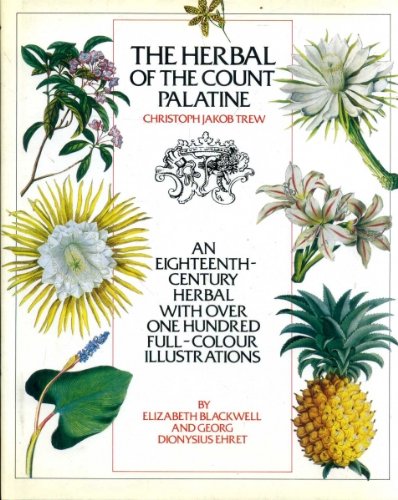
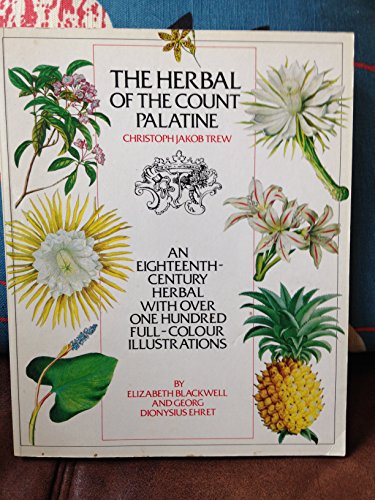
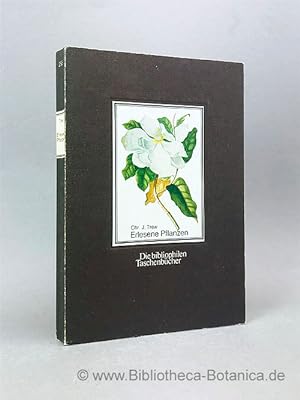
![Image du vendeur pour Plantae selectae quarum imagines ad exemplaria naturalia Londini, in hortis curiosorum nutritamanu artificiosa doctaque pinxit Georgius Dionysius Ehret . ; occasione haud vulgari collegit nominibus propriis notisque subinde illustravit et publico usui dicavit D. Christophorus Iacobus Trevv . ; in aes incidit et vivis coloribus repraesentavit primum Ioannes Iacobus Haid . pictor et chalcographus augustanus. Volume 1-10 [LeatherBound] mis en vente par True World of Books](https://pictures.abebooks.com/inventory/md/md31533652762.jpg)
